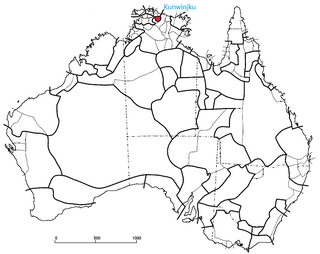The Bakanambia, also known as the Wanbara, are an Aboriginal group of Australia. Traditionally, the Bakanambia lived in the vicinity of Princess Charlotte Bay in the state of Queensland. One of the ethnonyms applied to them was Lama Lama, which is now used of a larger aggregation of remnants of several tribes.

Kuringgai is an ethnonym referring to an Indigenous Australian people who once occupied the territory between the southern borders of the Gamilaraay and the area around Sydney, and an historical people with its own distinctive language, located in part of that territory.

The Kunwinjku people are an Australian Aboriginal people, one of several groups within the Bininj people, who live around West Arnhem Land to the east of Darwin, Northern Territory. Kunwinjku people generally refer to themselves as "Bininj" in much the same way that Yolŋu people refer to themselves as "Yolŋu".
Wadjiginy, also known as Wagaydy (Wogait) and Batjamalh, is an Australian Aboriginal language. Apart from being closely related to Kandjerramalh, it is not known to be related to any other language, though it has borrowed grammatical and lexical material from neighboring Northern Daly languages.
The Mati Ke, also known as the Magatige, are an Aboriginal Australian people, whose traditional lands are located in the Wadeye area in the Northern Territory. Their language is in danger of extinction, but there is a language revival project under way to preserve it.
The Ngan'gimerri, also spelt Nangiomeri, Nanggumiri, and other variants, are an Aboriginal Australian people of the Daly River area in the Northern Territory.
The Marranunggu are an Aboriginal Australian people and language group, of the Northern Territory.
The Maung people, or Warruwi, are an Aboriginal Australian people living on the Goulburn Islands, in the Arafura sea off the coast of the Northern Territory.
The Ngaku were an Australian Aboriginal tribe located around the Macleay River of New South Wales. They were a predominantly coastal people. Although their language was not recorded, it was described as a dialect or accent of Dhanggati.
The Marimanindji are an indigenous Australian tribe of the Northern territory. Little is known of them.
The Menthe, occasionally called Menthajangal (Menhdheyangal), are an indigenous Australian people of the Northern Territory.
The Wadjiginy, also referred to historically as the Wogait, are an indigenous Australian people of the Northern Territory, specifically from just north of modern-day Darwin. The Wadjiginy are a saltwater people who describe themselves as wagatj 'beach-dwellers' from the Batjamalh word wagatj 'beach'.
The Djerimanga also known as the Wulna are an Indigenous Australian people of the Northern Territory.
The Dalabon or Dangbon are an Australian Aboriginal people of the Northern Territory.
The Mangarayi, also written Mangarai, were an Indigenous Australian people of the Northern Territory.
The Yeidji, also spelt Yiiji and other variants, commonly known as Gwini/ Kwini, are an Aboriginal Australian people of the Kimberley area of Western Australia, who also self-identify as Balanggarra.

The Warrwa, also spelt Warwa, are an Aboriginal Australian people of the Kimberley region of Western Australia.
The Ngardi, also spelled Ngarti, are an Aboriginal Australian people of the Northern Territory and Western Australia.
The Malngin are an Aboriginal Australian people of the Kimberley region of Western Australia. The Malngin language was a dialect of Gurindj.
The Djerait were an indigenous Australian people of the Northern Territory